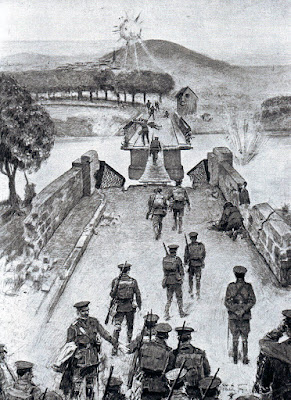The Battle of the Aisne took place between the 13th to 18th September 1914 following the German withdrawal from the River Marne.
The Battle of the Marne brought an end to the German Schlieffen Plan that intended to defeat France before Russia mobilised. The battle had created a gap between the German First and Second Armies which resulted in the German armies in the west withdrawing to the River Aisne.
 |
| German Cavalry withdrawing to the River Aisne |
The French and British Armies advanced in pursuit. The Germans began to prepare defences on the high ground north of the River Aisne.
 |
| German defences on the River Aisne |
They formed a new army, the seventh to fill the gap between the First and Second Armies.
 |
| Battle of the Aisne Strategic Situation |
The French and British forces reached the River Aisne by the 12th of September. Their intent was to force passage across the River Aisne in order to secure the high ground on the north bank on which the German Army had began to entrench.
The British Expeditionary Force Operation Order no 23 issued on 12th September defined the intent; The Army will continue pursuit at 7 am 13th September and reach a line Terny—Chavignon-Lierval.
The British Expeditionary Force (BEF) were located along the River Aisne between Soissons and Bourg. The ground along the valley was flat agricultural land with no natural cover between steep valley sides. The northern plateau commanded good fields of fire.
 |
| River Aisne Valley |
In the BEF’s area were a number of bridges across the River Aisne and the Canal Lateral which ran parallel to the river. The German engineers made attempts to destroy the bridges. The British Expeditionary Force were five Divisions strong and bridges were allocated to the Divisions for passage across the River Aisne.
 |
| River Aisne Battlefield |
The bridge at Venizel was allocated to the 4th Division, part of III Corps.
 |
| River Marne Pont de Venizel |
One of the four charges placed on the bridge by the Germans had failed. Whilst the bridge was damaged, the Royal Engineers deemed it could be used with care. On the night of the 12th / 13th September men of the 11th Brigade began to pass over the bridge in single file. The contents of ammunition carts were unloaded and passed by hand over the damaged bridge.
By 03:00 the Brigade of 4,000 men had crossed in the dark in single file and were in position to launch an attack at first light securing the high ground above the bridge. The following morning 12th Brigade crossed and the Royal Engineers began strengthening the bridge. The 10th Brigade remained on the south bank to secure the bridge.
 |
| River Marne Pont de Venizel IJ |
The British Expeditionary Force (BEF) through III Corps efforts had established their first bridgehead on the North bank of the Aisne. The remainder of the BEF, I and II Corps waited till daybreak before attempting to cross their allocated bridges.
The bridge at Missy allocated to the 5th Division of II Corps was found to have had two of it’s three spans had been destroyed. The Royal Engineers were tasked to build a raft capable of carrying 60 men as a means of crossing the river. The 14th Brigade supported by 121 Battery Royal Field Artillery would protect the crossing point.
 |
| River Marne Missy |
 |
| 18 pounder guns River Aisne |
The Sappers completed the raft by 12:00 and began to ferry 14 Brigade across the Aisne. Heavy fighting took place during the afternoon and the evening. The action succeeded and 14 Brigade established them selves on the north bank. The 15th Brigade began moving across the river at 21:00. The Royal Engineers built some smaller rafts and obtained a boat aiding the passage. The 15th Brigade and part of the 13th Brigade were complete on the north bank at first light.
It was the Missy crossing point where Captain William Johnston of the Royal Engineers was awarded the Victoria Cross for his actions on 14 September 1914.
His citation read:
At Missy, on 14th Sept., under a heavy fire all day until 7 p.m., worked with his own hand two rafts bringing back wounded and returning with ammunition; thus enabling advanced Brigade to maintain its position across the river.
— The London Gazette, No. 28985, 25 November 1914
 |
| Capt Johnston Royal Engineers VC action |
It was assessed the crossing would be heavily defended and possibly a trap to entice the British into the open ground. It was decided not to attempt to use the Bridge at Conde.
 |
| 5th Brigade crossing Pont D'Arcy |
 |
| 1st Battalion Loyal North Lancashire Regiment Memorial Cerny |
 |
| 1st Battalion Loyal North Lancashire Regiment Memorial Cerny |
 |
| British troops entrenching in the River Aisne valley |







































